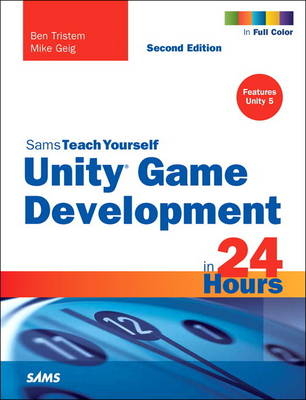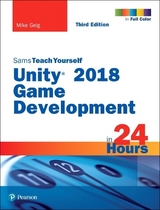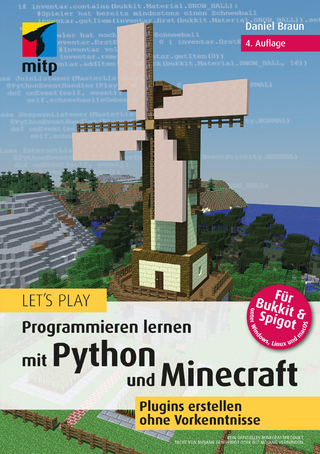
Unity Game Development in 24 Hours, Sams Teach Yourself
Sams Publishing (Verlag)
978-0-672-33751-2 (ISBN)
- Titel erscheint in neuer Auflage
- Artikel merken
In just 24 lessons of one hour or less, Sams Teach Yourself Unity Game Development in 24 Hours will help you master the Unity 5 game engine at the heart of Hearthstone: Heroes of Warcraft, Kerbal Space Program, and many other sizzling-hot games!
This book’s straightforward, step-by-step approach teaches you everything from the absolute basics through sophisticated game physics, animation, and mobile device deployment techniques. Every lesson builds on what you’ve already learned, giving you a rock-solid foundation for real-world success.
Step-by-step instructions carefully walk you through the most common Unity game development tasks.
Practical, hands-on examples show you how to apply what you learn.
Quizzes and exercises help you test your knowledge and stretch your skills.
Notes and tips point out shortcuts and solutions.
Learn how to…
Get up and running fast with the Unity 5 game engine and editor
Work efficiently with Unity’s graphical asset pipeline
Make the most of lights and cameras
Sculpt stunning worlds with Unity’s terrain and environmental tools
Script tasks ranging from capturing input to building complex behaviors
Quickly create repeatable, reusable game objects with prefabs
Implement easy, intuitive game user interfaces
Control players through built-in and custom character controllers
Build realistic physical and trigger collisions
Leverage the full power of Unity’s Mecanim animation system
Integrate complex audio into your games
Use mobile device accelerometers and multi-touch displays
Modify desktop games for mobile platforms
Apply the “finishing touches” and deploy your games
Ben Tristem is an internet entrepreneur, focusing on teaching technical subjects to beginners. Ben has been passionate about using computers since the days of the ZX81, and is now a world-class technology trainer. At the time of writing, Ben has over 60,000 students and more than 1,200 5-star reviews on his online courses. In previous lives, Ben has been an RAF pilot, financial trader, stunt man, helicopter pilot, franchise creator, and more. Now that he has two kids, Toby and Lucy, he has settled down to focus on what he loves—teaching. Mike Geig is both an experienced teacher and game developer, with a foot firmly in both camps. Mike is a Trainer for Unity Technologies where he develops and delivers recorded, live, and onsite learning content. He enjoys loitering and accordions. His Pearson video series, Game Development Essentials with Unity 4 LiveLessons, is a key title on Unity and rumor has it that people really enjoyed the first edition of Sams Teach Yourself Unity Game Development in 24 Hours. Mike was once set on fire and has over a million “likes” on Facebook.
Preface xiii
HOUR 1: Introduction to Unity 1
Installing Unity 1
Getting to Know the Unity Editor 4
Navigating the Unity Scene View 17
Summary 19
Q&A 19
Workshop 19
Exercise 20
HOUR 2: Game Objects 21
Dimensions and Coordinate Systems 21
Game Objects 25
Transforms 26
Summary 33
Q&A 33
Workshop 33
Exercise 34
HOUR 3: Models, Materials, and Textures 35
The Basics of Models 35
Textures, Shaders, and Materials 41
Summary 46
Q&A 46
Workshop 47
Exercise 47
HOUR 4: Terrain 49
Terrain Generation 49
Terrain Textures 57
Summary 61
Q&A 61
Workshop 61
Exercise 62
HOUR 5: Environments 63
Generating Trees and Grass 63
Environment Effects 71
Character Controllers 75
Summary 78
Q&A 78
Workshop 79
Exercise 79
HOUR 6: Lights and Cameras 81
Lights 81
Cameras 91
Layers 95
Summary 100
Q&A 100
Workshop 100
Exercise 101
HOUR 7: Game 1: Amazing Racer 103
Design 103
Creating the Game World 106
Gamification 108
Playtesting 114
Summary 116
Q&A 116
Workshop 116
Exercise 117
HOUR 8: Scripting—Part 1 119
Scripts 120
Variables 128
Operators 130
Conditionals 133
Iteration 136
Summary 137
Q&A 137
Workshop 138
Exercise 138
HOUR 9: Scripting—Part 2 141
Methods 141
Input 146
Accessing Local Components 151
Accessing Other Objects 153
Summary 158
Q&A 158
Workshop 158
Exercise 159
HOUR 10: Collision 161
Rigidbodies 161
Collision 163
Triggers 167
Raycasting 169
Summary 171
Q&A 171
Workshop 172
Exercise 172
HOUR 11: Game 2: Chaos Ball 173
Design 173
The Arena 175
Game Entities 179
The Control Objects 183
Improving the Game 187
Summary 187
Q&A 187
Workshop 188
Exercise 188
HOUR 12: Prefabs 189
Prefab Basics 189
Working with Prefabs 192
Summary 198
Q&A 198
Workshop 198
Exercise 199
HOUR 13: 2D Games Tools 201
The Basics of 2D Games 201
Orthographic Cameras 204
Adding Sprites 205
Draw Order 209
2D Physics 212
Summary 214
Q&A 215
Workshop 215
Exercise 215
HOUR 14: User Interfaces 217
Basic UI Principles 217
The Canvas 218
UI Elements 223
Canvas Render Modes 230
Summary 232
Q&A 233
Workshop 233
Exercise 233
HOUR 15: Game 3: Captain Blaster 237
Design 237
The World 238
Controls 247
Improvements 255
Summary 255
Q&A 255
Workshop 256
Exercise 256
HOUR 16: Particle Systems 257
Particle Systems 257
Particle System Modules 259
The Curve Editor 270
Summary 273
Q&A 273
Workshop 273
Exercise 273
HOUR 17: Animations 275
Animation Basics 275
Animation Types 277
Animation Tools 281
Summary 288
Q&A 288
Workshop 289
Exercise 289
HOUR 18: Animators 291
Animator Basics 291
Configuring Your Assets 296
Creating an Animator 305
Scripting Animators 314
Summary 315
Q&A 315
Workshop 316
Exercise 316
HOUR 19: Game 4: Gauntlet Runner 317
Design 317
The World 318
The Entities 321
The Controls 329
Room for Improvement 336
Summary 336
Q&A 336
Workshop 336
Exercise 337
HOUR 20: Audio 339
Audio Basics 339
Audio Sources 341
Audio Scripting 346
Summary 349
Q&A 349
Workshop 349
Exercise 350
HOUR 21: Mobile Development 353
Preparing for Mobile 353
Accelerometers 357
Summary 361
Q&A 362
Workshop 362
Exercise 362
HOUR 22: Game Revisions 365
Cross-Platform Input 365
Amazing Racer 368
Chaos Ball 372
Captain Blaster 374
Gauntlet Runner 375
Summary 376
Q&A 376
Workshop 376
Exercise 377
HOUR 23: Polish and Deploy 379
Managing Scenes 379
Persisting Data and Objects 381
Unity Player Settings 384
Building Your Game 387
Summary 391
Q&A 391
Workshop 391
Exercise 392
HOUR 24: Wrap Up 393
Accomplishments 393
Where to Go from Here 395
Resources Available to You 396
Summary 397
Q&A 397
Workshop 397
Exercise 398
Index 399
| Verlagsort | Indianapolis |
|---|---|
| Sprache | englisch |
| Maße | 179 x 232 mm |
| Gewicht | 812 g |
| Themenwelt | Informatik ► Software Entwicklung ► Spieleprogrammierung |
| ISBN-10 | 0-672-33751-7 / 0672337517 |
| ISBN-13 | 978-0-672-33751-2 / 9780672337512 |
| Zustand | Neuware |
| Informationen gemäß Produktsicherheitsverordnung (GPSR) | |
| Haben Sie eine Frage zum Produkt? |
aus dem Bereich



